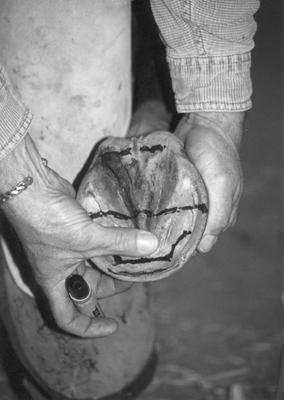| Published in the June 2000 Issue of Anvil Magazine
Please note: The complete version of this interview is located in
our Full Content Area which is available to
Anvil Magazine subscribers and Anvil Online members. Images and Captions are included at the bottom of this article. ANVIL: What are the landmarks used to find the coffin bone? GENE: Well, the first thing I look for is the widest part of the foot. That's the most st reference. It always stays the same in its relationship to the coffin bone and hoof capsule. ANVIL: How does this correspond to the center of the foot? GENE: The center of the foot corresponds to the center of articulation above it, which is at the widest part of the foot. When I talk about the center of the foot, that's what I am making reference to. With very little variation, I find that the inside edge of the sole callous at the center of the toe is a landmark that is a very reliable indication of where the optimal point of breakover should be. According to Dr. Page, with whom we have been working over the years, there are some variations between feet that tend to be more flat and those that tend to be more upright (presented by Dr. Page at the AAEP meeting, 1999). There's about a quarter of an inch range there, which, without a radiograph, may be slightly off. But there is certainly a little bit of room for a small margin of error in a foot that shows no signs of pathology. ANVIL: So the variable is not environment, then, it's the conformation of the foot, whether it's more upright or more flat? GENE: Right - how the callous distends or grows out of the position of the coffin bone. It's almost like an extension of the coffin bone, you might say. And it's a protective mechanism that is just on the outer border of the bone. If the foot is flat, the breakover will be at the back edge of the callous. As you look at a lot of feet, you start seeing a pattern. If the foot is more upright, you'll find the breakover point is about a quarter of an inch forward of the back edge of the callous. So the callous is a reliable reference in the field without x-rays in the foot without pathology. ANVIL: So you identify the sole ridge, or the back edge of the callous before you start trimming the foot? What happens once you start trimming the foot? GENE: Before trimming the wall, the chalky material of the sole can be cut back to..... <End of Abstract>
Please note: The complete version of this interview is located in
our Full Content Area which is available to
Anvil Magazine subscribers and Anvil Online members.
CAPTIONS AND IMAGES
(Image # 1 of 5 in complete interview)
Return to the June 2000 Table of Contents |
 The easiest way to find the landmarks is to use a felt pen, as illustrated,
before the foot is trimmed. The line across the middle is the widest part
of the foot. The line forward of Mark Plumlee's thumb is the approximate
point of breakover. This illustrates how to use your thumb as an increment
of measurement from the apex of the frog. The area between the two lines
at the toe is the sole callous.
The easiest way to find the landmarks is to use a felt pen, as illustrated,
before the foot is trimmed. The line across the middle is the widest part
of the foot. The line forward of Mark Plumlee's thumb is the approximate
point of breakover. This illustrates how to use your thumb as an increment
of measurement from the apex of the frog. The area between the two lines
at the toe is the sole callous.